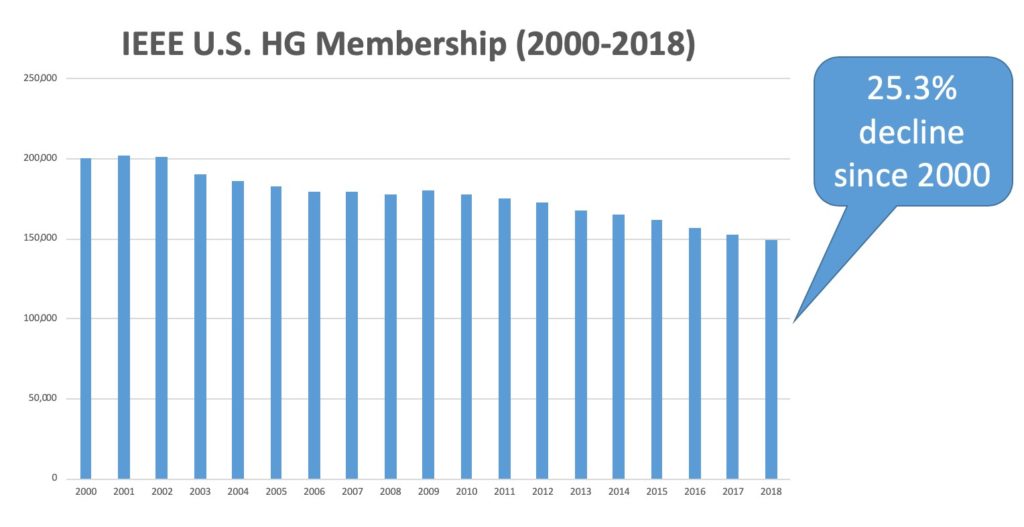
U.S. IEEE Regions have been losing members for decades, generally by a percent or two each year. As the chart below indicates, higher-grade membership in the United States has declined more than 25% between 2000 and 2018 – including an almost 10% decline since 2014. The termination of non-renewing members from 2018 was completed in late February 2019. U.S. IEEE higher-grade membership declined 2.0% (just over 3,000 members) from 2017 to 2018.
The causes for the loss in higher-grade IEEE membership in the United States are numerous, some of which are related to changes in the needs of younger professionals, decreases in corporate support for IEEE membership, and lower growth in the traditional disciplines that supported many IEEE members in the past.
However, there is a great value in human networking and in a professional community that supports and informs its members, and helps them stay up-to-date and employable. The needs of our technical community have changed, but the value of such a community has not. But how can we enhance and publicize the value of the IEEE technical community in a way that is relevant to modern young professionals?

I believe one of the best ways to do this is to create and collect existing materials that can be used to share and train our volunteer leaders in best practices for creating community-focused local IEEE Sections. After all, many of our U.S. members get their greatest value from technical meetings and other events at their local Section level. Work is going on that could lead to collecting such materials from our volunteers and staff and making them available online in an easy-to-find format.
One best practice that I want to encourage our Sections to pursue now is to promote the fact that IEEE is currently offering full-year memberships for half price to new members (NEW applications received between 1 March and 15 August 2019 will automatically be processed for half-year membership ending 31 December 2019 at the half-year dues rates). This is also the best time to try and recover prior members who didn’t renew in 2018. The best way to recover these members is by having members from their local IEEE community reach out to them.
In 2015, when I was director of IEEE Region 6 (the western United States) we worked with Chris Wright from Member and Geographic Activities (MGA) membership to create a micro-volunteering project to have IEEE member volunteers living in local IEEE Sections call (or email if they couldn’t connect by phone) 10 people who had not renewed their membership in 2014. We provided a script for these calls that the volunteers could use to find out why they didn’t renew, find out what their impressions of the IEEE are, and get their input on what we can do better.
If the non-renewing member was interested in renewing their membership, they were offered options for renewing their membership. We provided a spreadsheet for volunteers to keep notes from their discussions and a google doc where they could upload this data and share it with the overall membership drive community. Here are some results from this 2015 membership recovery challenge:
Through the end of May 2015, Region 6 volunteers reached out to 285 non-renewing members. Of the calls made 31.6% connected and 42.5% had a message that was left via voicemail or followed up with an email. The effort paid off, in that 19% of these contacts ultimately ended up renewing. The team was also able to glean valuable insights into why members did not renew.
Remarkably, 22% of the members that were contacted cited that they simply forgot to renew. Eleven percent cited financial reason/expense as the major reason they did not renew. The remaining reasons ranged from changes in technical interests to the fact they were just too busy.
In 2019, if we can do such a micro-volunteering member-recovery project at the local Section level, we can take an important step to eliminating our net loss of members this year. The time to start on this is now.
We are making some of our 2015 Region 6 member-recovery materials available for you to access, modify and use in a local Section membership-recovery project, where local volunteers each contact a few non-renewing members, keep track of their findings and share them with their Section, region and MGA. If you are interested in running this project in your Section, please contact Chris Wright (wright.c@ieee.org) of IEEE’s Member and Geographic Activities staff for more details.
Community matters, and we are all part of a local and larger community of technical professionals. Let your local community know that they are needed. If we show that we care, they may care as well. Let’s go out and bring our non-renewing members back, or at least find out why they left.
Find out more about member dues at: https://www.ieee.org/membership/join/dues.html

Tom Coughlin
IEEE-USA President, 2019







Remove the restrictions on IEEE Explore! As I am paying over $200 for my membership, I should have total access to all journals and publications.
My LA library card give me that for free.
When I joined IEEE many years ago, it was not so much to access journals or attend conferences. Instead, I joined because my friends and colleagues were IEEE members and encouraged me to do the same. In other words, the social value of IEEE membership should not be ignored. It is at the Section or Chapter level that social bonds can best be built and maintained. Encouraging friends and colleagues to become or remain IEEE members can have great impact.
“The needs of our technical community have changed, but the value of such a community has not. ”
Time to wake up folks. What does IEEE provide in terms of community that doesn’t exist for free elsewhere on the internet? Open source projects, free books, free courses all provide ways to keep the modern practitioner up to date.
This plus the fact that IEEE is incapable of making its presence known outside the IEEE. There was a time when most technical people knew wifi as the IEEE 802.11a through n. Now it is just wifi. Similar issues with other IEEE standards.
With IEEE being largely invisible to engineers outside of IEEE, and the free sources that are available to any who care to use them, it is hard to see how the value of IEEE membership has done anything but lost value over the years.
The ones leaving the IEEE are letting the IEEE know that the value of membership is not what it once was.
One possible reason for members not renewing – mature, seasoned professionals are being laid off and experiencing age discrimination in securing a new position. One enabler of age discrimination in hiring is companies increasingly turning to H-1B, F1 OPT, L-1, et al visa holders. In many cases (Disney, Southern California Edison, and others) American IT pros are required to train their non-immigrant work visa holder replacement prior to being laid off.
IEEE-USA has taken a strong stand on H1-B visa abuse, publishing a position statement and working with supportive members of Congress to achieve reforms. With volunteers like you, Rodney, we could have an even greater impact. Contact me at brendan.godfrey@ieee.org, if you wish to make a difference.